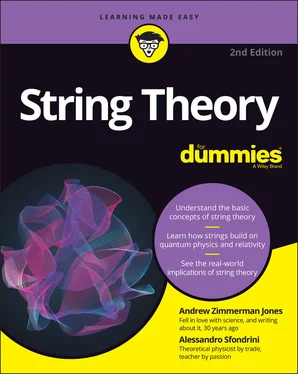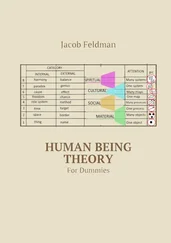String theory makes new predictions about physical systems that contain a large amount of energy packed into a very small space. The energies needed for string theory predictions are so large that it may never be possible to construct a device able to generate that much energy and directly test the theory’s new predictions. String theory also works when the energies are small, in which case it reproduces the “usual” laws of gravity, as we expect.
The energy of motion: Kinetic energy
Kinetic energy is most obvious in large objects, but it’s present in objects of all sizes, down to molecules and atoms. Heat (or thermal energy ) is really just a bunch of atoms moving rapidly, representing a form of kinetic energy. When water is heated, the particles accelerate until they break free of the bonds with other water molecules and become a gas. The motion of particles can cause energy to be emitted in different forms, such as when a burning piece of coal glows white hot.
Sound is another form of kinetic energy. If two billiard balls collide, the particles in the air will be forced to move, resulting in a noise carried by a wave. Normally this is a tiny amount of energy, but it can actually reach destructive levels when we consider the blast of an explosion or the waves in a fluid other than air — for instance, a tsunami in the ocean. It turns out that light and radiation are also described by waves, and they also carry energy, but they do so in a different way than sound waves and ocean waves do. We will come back to this in Chapter 7.
Stored energy: Potential energy
Potential energy is stored energy. Potential energy takes many more forms than kinetic energy and can be a bit trickier to understand.
A spring, for example, has potential energy when it’s stretched out or compressed. When the spring is released, the potential energy transforms into kinetic energy as the spring moves into its least energetic length.
Moving an object in a gravitational field changes the amount of potential energy stored in it. A penny held out from the top of the Empire State Building has a great deal of potential energy due to gravity, which turns into a great deal of kinetic energy when it’s dropped (although not, as demonstrated on an episode of MythBusters, enough to kill an unsuspecting pedestrian on impact).
It may sound a bit odd, talking about something having more or less energy just because of where it is, but the environment is part of the physical system described by the physics equations. These equations tell us exactly how much potential energy is stored in different physical systems, and they can be used to determine outcomes when the potential energy gets released.
Symmetry: Why some laws were made to be broken
A change in location or position that retains the properties of the system is called a geometric symmetry (or sometimes translational symmetry ) . Another form of symmetry is an internal symmetry, which is when something within the system can be swapped for something else and the system (as a whole) doesn’t change. When a symmetrical situation at high energy collapses into a lower energy ground state that is asymmetrical, it’s called spontaneous symmetry breaking . An example would be when a roulette wheel spins and slows into a “ground state.” The ball ultimately settles into one slot in the wheel — and the gambler either wins or loses.
String theory goes beyond the symmetries we observe to predict even more symmetries that aren’t observed in nature. It predicts a necessary symmetry that’s not observed in nature called supersymmetry. At the energies we observe, supersymmetry is an example of a broken symmetry, though physicists believe that in high-energy situations, supersymmetry would no longer be broken (which is what makes it so interesting to study). We cover supersymmetry in Chapters 2and 10.
Translational symmetry: Same system, different spot
If an object has translational symmetry, you can move it and it continues to look the same (for a detailed explanation of this, flip to Chapter 4). Moving objects in space doesn’t change the physical properties of the system.
Now, didn’t we just say in the last section that the potential energy due to gravity changes depending on where an object is? Yes, we did. Moving an object’s location in space can have an impact on the physical system, but the laws of physics themselves don’t change (so far as we can tell). If the Empire State Building, Earth, and the penny held over the edge (the entire “system” in this example) were all shifted by the same amount in the same direction, there would be no noticeable change to the system.
Internal symmetry: The system changes, but the outcome stays the same
In an internal symmetry , some property of the system can undergo a change without changing anything that we may measure in an experiment.
For example, changing every particle with its antiparticle — changing positive charges to negative and negative charges to positive — leaves the electromagnetic forces involved completely identical. This is a form of internal symmetry called charge conjugation symmetry.
Spontaneous symmetry breaking: A gradual breakdown
Physicists believe that the laws of the universe used to be even more symmetric but have gone through a process called spontaneous symmetry breaking, where the symmetry falls apart in the universe we observe.
If everything were perfectly symmetric, the universe would be a very boring place. The slight differences in the universe — the broken symmetries — are what make the natural world so interesting, but when physicists look at the physical laws, they tend to find that the differences are fairly small in comparison to the similarities.
 To understand spontaneous symmetry breaking, consider a pencil perfectly balanced on its tip. The pencil is in a state of perfect balance, of equilibrium, but it’s unstable. Any tiny disturbance will cause it to fall over. However, no law of physics says which way the pencil will fall. The situation is perfectly symmetrical because all directions are equal.
To understand spontaneous symmetry breaking, consider a pencil perfectly balanced on its tip. The pencil is in a state of perfect balance, of equilibrium, but it’s unstable. Any tiny disturbance will cause it to fall over. However, no law of physics says which way the pencil will fall. The situation is perfectly symmetrical because all directions are equal.
As soon as the pencil starts to fall, however, definite laws of physics dictate the direction it will continue to fall. The symmetrical situation spontaneously (and, for all intents and purposes, randomly) begins to collapse into one definite, asymmetrical form. As the system collapses, the other options are no longer available to the system.
The Standard Model of particle physics, as well as string theory (which includes the Standard Model in an appropriate limit), predicts that some properties of the universe were once highly symmetrical but have undergone spontaneous symmetry breaking into the universe we observe now.
All Shook Up: Waves and Vibrations
In string theory, the most fundamental objects are tiny strings of energy that vibrate or oscillate in simple, regular patterns. In physics, such systems are called harmonic oscillators. Harmonic oscillators are the simplest (and in many ways most universal) physical system that you will ever encounter.
 Though the strings of string theory are different, understanding the vibrations of classical objects — like air, water, jump ropes, springs — can help you understand the behavior of these exotic little creatures when you encounter them. These classical objects can carry what are called mechanical waves.
Though the strings of string theory are different, understanding the vibrations of classical objects — like air, water, jump ropes, springs — can help you understand the behavior of these exotic little creatures when you encounter them. These classical objects can carry what are called mechanical waves.
Читать дальше

 To understand spontaneous symmetry breaking, consider a pencil perfectly balanced on its tip. The pencil is in a state of perfect balance, of equilibrium, but it’s unstable. Any tiny disturbance will cause it to fall over. However, no law of physics says which way the pencil will fall. The situation is perfectly symmetrical because all directions are equal.
To understand spontaneous symmetry breaking, consider a pencil perfectly balanced on its tip. The pencil is in a state of perfect balance, of equilibrium, but it’s unstable. Any tiny disturbance will cause it to fall over. However, no law of physics says which way the pencil will fall. The situation is perfectly symmetrical because all directions are equal.










